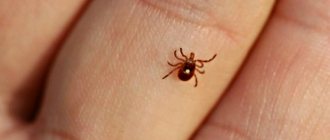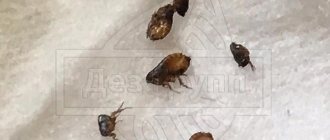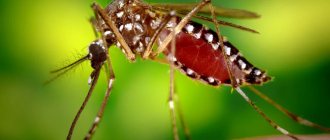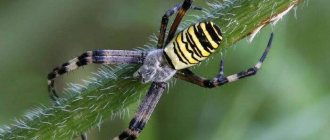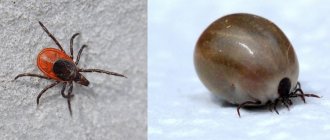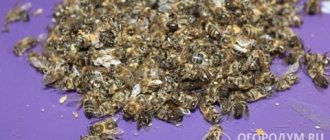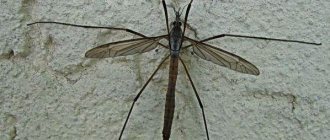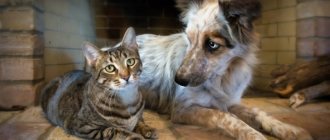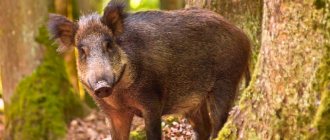Social structure and reproduction
Photo: Little flea
Life cycle details are available for only a few flea species. They have four life stages - egg, larva, pupa and adult. Pearly white, oval eggs are laid on the body, nest, or habitat of the host animal.
Read also: Direction of the magnetic induction vector
The larva is small and legless and feeds on organic debris such as dried excrement, dried pieces of skin, dead mites or dried blood found in the host's nest. Adult fleas quickly pass freshly absorbed blood through the intestines to produce feces to feed their babies, which is necessary for the successful metamorphosis of some species of flea larvae.
After three (in rare cases two) molts, the larva unwinds a silk cocoon, which includes debris from the nest and enters the pupal stage. The pupa develops into an adult after a few days or months. Some species may enter a developmental arrest at the end of the pupal stage and will not become adults until a host emerges. Depending on the species or environmental conditions, the time required for a flea to complete its life cycle varies from two weeks to several months.
Interesting fact: The lifespan of an adult flea ranges from a few weeks (for example, Echidnophaga gallinacea) to a year or more (Pulex allerans).
Nutrition
What do fleas eat? Fleas feed exclusively on the blood of their hosts, or donors, on whose bodies they successfully parasitize. The main victims of fleas are mammals, whose life at any time of the year is connected with the presence of a shelter. But animals that live in burrows and nests only periodically are less susceptible to flea attacks. Typically, fleas do not live on the body of their owner all the time, but jump there only to feed on their blood; having had their fill, they jump into the litter of a hole or nest.
Some fleas are associated with animals that do not have permanent housing at all; these types of fleas are stationary parasites, that is, once on the host’s body, they no longer leave it. These fleas include fleas that live on dogs and cats.
Unlike mosquitoes, in which only females are bloodsuckers, in fleas both males and females suck blood equally. The process of saturation with blood can last from one minute to several hours. Sometimes fleas are saturated with blood in reserve, significantly inflating their abdomen.
Stationary fleas have a need for regular feeding, this is another reason why they do not leave the host’s body on their own. In between meals, they wander freely in the skin of their prey.
Interestingly, most types of fleas can parasitize different animals, for example, jump from a squirrel to a dog or cat. The only exception is bat fleas, which require only bats as hosts.
How dangerous are fleas to humans?
It is naive to believe that pests that live on animals are not dangerous to humans.
Fighting methods
1. Specialized sprays, aerosols.
What should be done:
- Pre-wet clean the apartment, shake out the carpets, wash things and bedspreads at maximum temperature.
- Move furniture away from the walls and ensure the absence of household members.
- Spray the product over the maximum area, paying special attention to upholstered furniture.
- Close the windows and doors, leave the apartment for several hours, and then ventilate thoroughly.
- Do a general cleaning of the apartment again.
2. Preparations based on permethrin.
Such preparations include specialized insect repellent shampoos for pets, as well as room treatment products.
What should be done:
- If you purchased shampoo with permethrin to treat pets, then bathe your cat or dog using anti-flea shampoo, and then dry and comb the animal.
- Treat and wash all bedding and any objects with which the pet has been in contact with this product.
- After a week, repeat the procedure.
- Insecticidal powders.
What should be done:
- Sprinkle the powder throughout the apartment: along baseboards, under beds, cabinets, wardrobes, carpets.
- You don’t have to remove the product for a while, because... The number of insects in the house depends on the time it is spent.
What you will need:
- essential oil of the above herbs or dried plants;
- as an alternative: tar soap.
What should be done:
- Prepare a fairly concentrated aqueous solution of the essential oil of these herbs or brew dry herbs.
- Wash all surfaces and wash items using this solution.
- After a week, repeat the procedure.
If fleas were not carriers of deadly human diseases, people would not show such diligence in their destruction. But it was these insects, together with their immediate hosts - rats - that were the cause of devastating epidemics of bubonic plague in Europe. Even today, many populations of rodents - jerboas, gophers, gerbils - are kept under strict control by epidemiologists, since the deadly pathogen continues to incubate in the burrows of these animals.
In addition to the plague causative agent, other bacilli and viruses also actively move on fleas:
- hepatitis A and B viruses
- salmonella
- causative agent of brucellosis
- typhus pathogen
- encephalitis virus
- trypanosomes
- eggs of various helminths.
In total, more than 200 diseases dangerous to humans can be carried by one or another type of flea. And therefore flea bites are scary not only because of itching and redness...
We will only talk about those types of fleas that live in our homes. These are cat, dog and human fleas. What is their difference?
- Cat flea: The most common flea in the flea kingdom. On an animal it looks like small lumps of dirt. Dark discharge (excrement) also remains on the fur. The female lays eggs, resembling white grains, in cracks in floors, in the upholstery of upholstered furniture, and under carpets. It differs from the rest in its flat body and tiny head. Are cat fleas dangerous for humans? They feed on his blood when the main owner is not nearby.
- Dog flea: parasitizes dogs, cats, and horses. The body is slightly flattened on the sides. It does not often visit humans, but in severe hunger it will not disdain human blood. She jumps quite far: three times further than she sees. The bristles allow them to adhere well to the owner's fur.
- Human flea: Most often feeds on a person, especially if he has a characteristic odor and the hair is rich enough. Fleas can stay on humans for only a short time, moving onto cats or dogs. Signs of an “attack” are the presence of small wounds that itch very much. You can also notice a small dark dot on the body; this is an attached parasite that happily absorbs blood.
Are fleas dangerous for humans? A bite is not always dangerous, only in some cases it leads to dire consequences. The real threat is that by biting another animal, and then a person, the flea is capable of transmitting infections, infecting all its potential victims.
The bite is sensitive because an enzyme gets into the wound with the little vampire’s saliva, thanks to which the blood does not clot. Therefore, the flea can get plenty of food. A small pink spot remains at the site of the bite, which causes severe itching.
We suggest you familiarize yourself with: Flea capsule for cats
Most often, bites are clearly visible on the legs. They are located scattered, in the form of small pink dots a few centimeters from each other. Flea bites are also noticeable on other parts of the body: most often on the arms, neck and armpits. If flea bites are actually present on a person, then there is tar soap and flea shampoo intended for people. If you find pink sores on your child's body, you should consult a doctor.
Depending on the individual characteristics, various lesions occur on the skin:
- allergies of varying severity,
- tumors at the site of the bite,
- swelling occurs and internal hemorrhages are possible,
- wounds become infected and ulcers form,
- dermatitis develops.
Before fleas bite people, they can parasitize other animals, transmitting infection and becoming pathogens of diseases: plague, typhoid, tularemia, salmonellosis, hepatitis B and C. They can also transmit helminth eggs, which leads to the development of parasites inside the body .
The choice of products for home treatment is relatively small due to the food specialization of insects. They will not eat poisoned bait; their food is blood. If fleas have settled in a person’s apartment, they are destroyed using two substances that have different effects:
- Sprays and aerosols that penetrate the parasite's body with air. Due to the quick action, getting rid of fleas will not be difficult.
- Powders and suspensions that penetrate the chitinous integument of an insect. They do not act so quickly, they act thoroughly, destroying all parasites.
The most popular flea spray is Raptor. Also used for disinfection are Solfak, Chlorpyrimark, Tetrix, and Efficient Ultra. After treatment, the apartment should be thoroughly rinsed to destroy any remaining toxic drugs. There is no need to use any poisonous substances that come into your hands. This will not only not give results, but can also lead to mutation of fleas and in the future it will be even more difficult to remove them.
Effective Ultra
Chlorpyrimark
Raptor
Solfac
Tetrix
A specialized institution can also help, from where they call specialists to treat the premises. You just prepare the apartment and leave it. After treatment, the special service workers will explain how to clean the room from the toxic substance, give guarantees, and, if necessary, carry out re-treatment.
Where to start the fight
- If you have a pet, start with him. An infected pet should be examined especially behind the ears, face, and belly. Under the wings of birds. And treat it with antiparasitic drugs, of which there are a lot now. Anti-flea drugs are represented by all kinds of shampoos, sprays, drops, tablets and collars.
- If you suspect that fleas came from your neighbors or from the basement or attic, then most likely they are disturbing not only you. Interview your neighbors, if you are not alone, file a collective complaint and contact the SES.
- In your home, you can carry out disinfestation of the basement or attic yourself or call a special service.
- If there are rodents (rats, mice), first get rid of them yourself or by calling a pest control service.
- If you suspect items, shake them outside and wash them at maximum temperature.
Well, we’ve prevented the emergence of new parasites, now let’s take on the ones you have.
Life cycle, reproduction and development of a flea
The life cycle of parasites consists of the following stages:
- egg;
- larva;
- chrysalis;
- imago (adult).
The most comfortable temperature for breeding is 18-25 degrees (then they breed all year round). In cold weather they live but do not reproduce. Before mating, partners eat. The female climbs onto the male's back and takes the genital claw into the spermatic receptacle. Mating lasts several hours, and the seed moves into the female’s body within 15 minutes.
Eggs are laid in small portions. The female ejects small white eggs from her body; they are located quite far from each other. After two weeks, they hatch into translucent larvae without legs, similar to worms. They make their way inside the nest and feed on rotting organic matter, skin epithelium, and blood residues from the excrement of their parents. After three molts, the larva becomes a pupa (it wraps itself in a silk-like cocoon). This stage lasts from 5 days to several months (it depends on the climate). When a flea emerges from a pupa, it immediately looks for its owner.
Danger to humans
Fleas are one of the most dangerous ectoparasites. External danger is the following reactions of the body:
- allergic swelling;
- skin rashes;
- enlarged lymph nodes.
Among other things, the parasite can carry a number of diseases:
- typhus;
- tularemia;
- plague;
- anthrax;
- encephalitis.
In addition, a flea can transmit fungal diseases, listeriosis and salmonellosis to humans.
Flea bites
Flea bites cause stabbing pain when the skin is pierced and a strong desire to scratch the bitten area. A characteristic swelling usually appears at the site of the bite, somewhat similar to that from a cigarette burn. After the flea has eaten and detached itself, the edges of the wound converge, preventing bleeding, and a pinpoint hemorrhage forms at the site of the bite.
The main method of protection against little bloodsuckers is the complete destruction of fleas at home + prevention from them and other possible parasites (the same ticks) when going outdoors.
What diseases do fleas carry?
Flea bites can be very dangerous because fleas are carriers of disease. Fleas themselves cause two diseases in humans: pulicosis and sarcopsillosis (tungiasis), but insects can carry pathogens of other serious diseases, some of which are deadly. Diseases transmitted by fleas:
- plague (including bubonic);
- typhus (typhus and relapsing);
- encephalitis;
- hepatitis B, C;
- toxocariasis;
- trypanosomiasis;
- tularemia;
- listeriosis;
- pasteurellosis;
- intestinal yersiniosis;
- brucellosis and others.
Types of fleas
There are about 22 families of fleas, which include various species.
Read also: Vacation with a small child
- The human flea is the most common species. A brown insect up to 3.2 mm long, jump height 30 cm, length 50 cm. It has no thoracic or head teeth. Sucks the blood of humans and animals. Carries plague pathogens and causes pulicosis. The blood is sucked for up to 20 minutes and digested for 6 hours.
- The cat flea infests all animals, even humans. Carries many infections. The larvae develop in animal fur and bedding. Body length is up to 5 mm, females are larger - up to 1.6 cm. They live up to two years.
- The dog flea lives on dogs, cats and humans. Carries flatworms and other parasites, is the keeper of the pathogens of plague, leprosy, and Marseilles fever. Size up to 5 mm, lives up to 1.5 years.
- The rat flea is recognized as the most dangerous species, carrying plague, mouse and rat tapeworm. The length of females is 2.7 mm, males - 2 mm. Color ranges from light brown to darker. Females lay eggs in rat nests.
- The Tien Shan flea, as the name suggests, lives in the Tien Shan. The fertilized female increases in length, which gives them a worm-like appearance. The length of males is 4 mm, females – 5 mm, color black. Fleas appear in winter, rising from the frozen ground onto the body of livestock. The insects soon become larger, changing color to white.
- The grass flea (up to 3 mm long) lives on trees, bushes, grass, and gets into the apartment with the help of pets. It differs from other species in the presence of wings.
- The penetrating flea (sand flea, Brazilian ground flea) is native to Haiti, Brazil. Length 1 mm, jump height up to 35 mm. The fertilized female becomes round with a diameter of up to 1 cm. Lives in dry grass, jumps on humans, birds and animals. Males drink blood, and females get under the skin of animals' legs or human nails, causing inflammation and tetanus, which leads to gangrene, amputation, and in some cases death.
There is a species called the bed flea, which lives on upholstered furniture and bed linen (another name for linen flea). They bite a person at night in the areas of the body with the thinnest skin.
Fleas - description, characteristics, structure. What do fleas look like?
The flea's body length is only 1-5 mm, but females of certain species, after intensive feeding, reach a length of more than 1 cm due to their hypertrophied abdomen. The length of a fertilized female can be 1.5 cm. The largest fleas that parasitize moose have a body length of up to 1 cm.
The flea's body consists of a small head and abdomen, covered with a durable chitinous covering. If you look at a flea under a microscope, you can see how the insect’s body is flattened laterally, somewhat reminiscent of a shrimp. But this body shape is evolutionarily justified and allows the parasite to move unhindered in the feathers, thick fur of the host, in the substrate of burrows and nests, or in the folds of clothing.
SEM image of a flea in artificial flowers
The color of a flea can be yellowish, reddish, dark brown and even almost black.
The flea does not have wings, and this is no coincidence: a winged parasite is easier to crush, and the presence of adaptations for flight could complicate motor activity.
Thanks to 3 pairs of long, strong limbs, fleas often move by jumping, which is ensured by powerful pushes of the second and third pair of legs. Some types of fleas have relatively short legs and practically never leave the host's body. Each limb consists of 5 segments and ends in sharp forked claws.
The easy movement of the flea is also facilitated by numerous spines and bristles scattered throughout the body, as well as jagged combs and ctenidia located on the head. This structure of the flea is a kind of protection for the insect: all attempts to comb, pull out or bite the flea will end in failure. The only way to destroy a parasite is to crush it with a fingernail on a hard surface.
There are simple eyes on the head of the flea, and antennae grow behind them, with the help of which males hold females during mating. In a calm state, the flea's antennae are immersed in small antennal fossae.
Fleas have a piercing-sucking type of oral apparatus, which is characterized by the transformation into stylets of epipharynges (unpaired stylet) and lacinia (paired stylets), articulated with maxillary lobes. The parasite bites through the host's skin, widens the wound and releases saliva, which prevents blood clotting. The flea then plunges its body into the wound to reach the blood vessel. When feeding, fleas fill their stomachs with blood, which can become very swollen.
A distinctive feature of the structure of fleas is the presence of a pygidium, a special sensory organ located in the back of the abdomen. Tactile hairs covering the pygidium sensitively detect the slightest vibrations in the air and signal danger.
The reproductive organs of a female flea consist of oviducts, ovaries and a spermatic receptacle, which resembles a curved flask. Males are endowed with a copulatory organ - the genital claw.
Spreading
Fleas are found on all continents (even in Antarctica: Glaciopsyllus antarcticus). Fleas are mostly associated with temperate and subtropical climatic zones, therefore the bulk of species and genera are distributed in the East Asian, Central Asian, Western American, Patagonian, Papuan and East African zoogeographical subregions. The largest number of species was found in the Palaearctic (892 species from 96 genera), Nearctic (299, 68), Neotropic (289, 55) and Afrotropic (275, 43). The family Ischnopsyllidae is cosmopolitan. The families Hystrichopsyllidae and Ceratophyllidae are distributed almost worldwide. The families Stephanocircidae, Lycopsyllidae, Macropsyllidae, and Malacopsyllidae are found only in the southern hemisphere. Africa is characterized by the families Xiphiopsyllidae and Chimaeropsyllidae, and Australia by Lycopsyllidae and Macropsyllidae.
Nutritional Features
Due to the presence of a piercing-sucking mouthpart, fleas lead a parasitic lifestyle. They feed only on blood. Compared to other insects, blood protein is the main nutrition at any stage of flea development.
After piercing the skin, the flea secretes a special enzyme. It makes blood clotting slower.
How does the feeding process occur in parasites?
While learning everything about fleas, you cannot bypass the feeding process. The parasite pierces the host's skin and then injects saliva through a tube to prevent the clotting process. After which the flea sucks out the required amount of blood. The saliva itself can cause allergic reactions in animals and also cause anemia in kittens.
Few people know that some types of fleas in cats can consume about 15 times their own weight in blood every day.
Naturally, in order to get such an amount of nutritious product, the parasite has to make hundreds of bites a day. This results in slightly raised, swollen, itchy patches with a dark dot in the center (sometimes similar to a mosquito bite). Flea bite marks often appear in groups of two or three spots and can itch for several weeks. But lice usually do not leave bite marks on the scalp. They simply cause itching and cause hair loss. In rare cases, with severe head lice, lice may leave small, red bumps on the scalp, upper neck and shoulders, which may crust over over time.
How to detect fleas in an apartment?
Fleas are fairly small insects, so it is not immediately possible to detect their presence in the house. A good method to confirm the presence of parasites is a regular white sheet. It must be spread on the floor, and if the suspicions were thorough, then after a while dark insects will be noticeable on the light fabric. Another fact that will signal that fleas have appeared in a house or apartment will be red, slightly swollen spots on the skin - marks from flea bites: they appear in the morning, are often arranged in a chain and are unbearably itchy.
Life cycle
A flea is an insect with a full cycle of transformations. This means that in the process of its development it goes through the stages of egg, larva, pupa and adult insect. Each stage has its own characteristics of life and body structure.
Flea eggs are white and very small - up to 0.5 mm in length. Females carry them for the time being in their abdomen, and then scatter them anywhere, caring little about their offspring. They can be found between the fibers of the carpet, on leaves of grass, in bird nests, and in the litter of earthen burrows.
The period of larval growth in the egg is highly dependent on environmental conditions. The higher the temperature, the faster it will develop. On average, from the moment of laying to the hatching of the nymph, it takes from 7 to 10 days.
Larvae, or nymphs, have a completely different appearance from adult insects. Externally, these are small, up to 5 mm long worms of a dark or whitish color. As a rule, their body consists of 13 segments and is covered with sparse long hairs. At one end of the body there is a large head with well-developed strong jaws.
Upon closer inspection, it becomes clear that they have neither eyes nor legs. Yes, they don’t need them. Nymphs do not feed on the blood of animals and live in the substrate, where they arrived as eggs.
Having got out of it, the larvae immediately begin to feed. Anything that contains organic matter is suitable for them to eat:
- excrement of adult insects with remains of undigested blood;
- decaying animal food debris;
- pieces of leather;
- plant juice.
As the nymph grows, it molts three times and then rolls a silk cocoon around itself and pupates. As a rule, the entire period of larval development takes from 10 days to 4 weeks, however, again depending on the ambient temperature and the abundance of food, it can last up to several months.
Doll
The pupa is the penultimate stage of flea development before its transformation into an adult insect - imago. She will stay in a durable, silk cocoon from 5 days to several months. In this form, she can wait out the harsh winter, and when she thaws with the first warm rays of the sun, she can leave her house and go in search of her prey.
Interestingly, the pupa can time its birth to coincide with a certain moment. The slightest vibration of the surface of the earth from the paws of a cat or dog and in a few seconds a young hungry flea will appear from the cocoon.
An adult insect, or imago, lives about 1.5 - 2 months. However, its existence may extend indefinitely. The thing is that at critical temperatures below zero, it falls into a kind of hibernation and thus waits out the unfavorable period. Fleas also easily survive long-term hunger strikes. They can go without food for several months without harming their health.
Contrary to popular belief, fleas do not live on animals permanently. They attack only when they are hungry. The satiated bloodsucker jumps to the ground and hides until the next meal. As a rule, the digestion process takes about a day, after which the flea goes hunting again.
Adult fleas feed on blood for the rest of their lives. They need it not only to maintain life, but also to continue their kind.
Insects under a microscope
Microscope technology allows you to obtain a picture of any substance or creature, magnified so much that the human eye can perceive it. They began to examine various matters with the help of this device a long time ago, but recently it has become popular to study what is in close proximity to us and can be in contact.
A fly under a microscope looks, to put it mildly, strange. A little different from how we are used to seeing her, although the similarity is visible thanks to a pair of large compound eyes, divided into microscopic segments.
Look at the picture. Is this how you imagined this creature? Being so tiny, the fly is endowed with all the means necessary for its existence. It is thanks to these growths on her paws that she can hold on to any vertical surface, hang right on the ceiling and move the way she wants. Thanks to the villi that cover the body of the fly, the moisture that gets on it does not linger on the body.
The eyes of the fly, as can be clearly seen, are divided into equal sections. Some species of this insect also have special villi on them. With the help of such an organ, the fly sees everything.
We suggest you read: How to treat a bruised knee
The wings are also divided into sections. They are so thin that no one can see the thickness. This is only possible under a microscope. Translucent or dark, shimmering with all the colors of the rainbow or monochromatic - flies are surprisingly diverse creatures.
Amazing world
We are surrounded by a lot of amazing creatures, which at first glance seem to us the most ordinary.
Everyone knows the tale about the Tula blacksmith, nicknamed “Lefty,” who shoed a flea. Cossack Platov, who accompanied Tsar Alexander I on his travels, showed a steel flea brought from England to Tula craftsmen, one of whom surprised him. Examining the flea under a microscope, he discovered that there were tiny horseshoes on the flea, which were made by the blacksmith Lefty, which was proof of the amazing skill of Russian craftsmen. The shod flea looked extremely unusual under a microscope. Then the photo of the savvy flea spread around the world.
You can see what a flea looks like under a microscope in the photos below, and can also be seen in our video.
The size of the insect is extremely small - from 1 to 15 mm, so you will need a device with a lens at low magnification (5x). I must say that the sight is not a pleasant one. Flea eggs are viewed at higher magnification (10x), because have microscopic dimensions.
A flea close-up is a terrifying sight. The photo shows a frontal view of the insect. The head is small and sloping. Behind the simple eyes there are antennae, which the insect retracts into special pits when at rest. Males use antennae to hold the female during mating. This structure of the head ensures that it is deeply immersed in the epidermis of the victim in order to reach the capillary. This is what a flea looks like under an electron microscope in profile.
The oral apparatus of the piercing-sucking type is clearly visible. The upper pair of stilettos gnaws through the skin, the lower one widens the wound. The lower lip is a kind of case for the sucking proboscis. It also contains movable palps - organs of touch. From above, the oral apparatus is covered by a head plate with sharp comb-like projections - ctenidia.
The structural features of these blood-sucking insects also include the presence of a sensory organ characteristic only of this family – the pygidium. Localized behind the 8th segment, the pygidium is equipped with tactile hair-like outgrowths of chitin (trichobothria), which detect air vibrations and inform the insect about a threat.
Possible causes of fleas
Here are the main reasons why fleas appear in your home:
- You are a pet owner - dogs, cats, rodents, birds - they all can have these parasites
- Neighbors - If your neighbors have a pet, then fleas can get to you. Through loggias, balconies, through the ventilation system, and simply from the entrance
- The basement - homeless animals, rats and mice - is a breeding ground for these parasites
- Attics – Many homes have attics that are open to birds.
- Non-residential premises - shops, warehouses, etc.
- The first floors of the houses are from the street, they brought them in themselves or a cat just ran through
- Private houses can also be entered from the basement, street, barn, or premises where animals and birds are kept. They can get to you through windows, doors, ventilation, cracks in the floor and baseboards, etc.
Habitats
Fleas, especially household fleas, prefer to settle in all corners of the apartment. Moreover, they are located at a level of approximately 1.5 meters from the floor level.
Parasites often prefer secluded places:
- baseboards;
- cracks;
- bed;
- Stuffed Toys;
- palace
The ideal place to live is furniture or a kitchen sink.
Interesting facts about fleas
- In the Middle Ages, many ladies had fur on them, so they suffered from fleas more than others. Special boxes with slits called flea traps helped them fight parasites. They contained a cloth bait soaked in blood, resin or honey.
- At the court of King Louis XIV there was a special position - a page for catching fleas. The ladies were saved by special medallions with an adhesive substance inside.
- In the Middle Ages, fashionable fabrics were named after parasites - “Lovers Flea”, “Dreaming Flea Color”.
- The British Museum houses an impressive collection of fleas, which was collected by the banker and ethmologist Charles Rothschild.
- The flea market got its name because it used to sell clothes and second-hand items that were infested with vermin. Now the situation is completely different, but the name remains.
- It is believed that fleas dream of minor troubles.
Fleas are parasites that have long plagued both animals and humans. There are several types of insects, they are divided depending on the type of host. Parasites feed only on blood. Insect habitats include hidden corners of rooms and dust. The main danger to humans is the occurrence of allergic reactions, enlarged lymph nodes and the risk of contracting diseases that are difficult to treat.
Flea treatment in the apartment
Modern insecticidal preparations help get rid of household fleas and their larvae even in the most neglected rooms. Due to the fact that fleas are physically unable to eat poisonous bait, means to combat these parasites are available in the form of sprays, powders and suspensions. The principle of action of any flea remedy is to damage the nervous system of insects, which leads to paralysis.
- Aerosol preparations imply large-scale treatment of the premises with the preliminary evacuation of all inhabitants of the apartment, subsequent ventilation and wet cleaning.
- contact powder preparations are scattered under baseboards, cabinets, and behind beds.
- Liquid microcapsule flea products are good because they do not wash out even after cleaning.
The best and most effective home remedies for fleas:
- Spray Raptor “Against crawling insects”: a safe and effective product with a pleasant mint scent. Two cylinders are enough to treat a 1-room apartment;
- Combat spray is an equally effective analogue of Raptor, with the aroma of lemon and mint;
- Sinuzan is a professional flea remedy that reliably protects the room, the only drawback of which is the unpleasant odor;
- Chlorpirimak is used to combat the Colorado potato beetle and leaf beetles, and also perfectly helps to remove household fleas;
- Biorin is a professional drug that requires a serious approach to use. Destroys not only fleas, but also any other parasites;
- Pyrethrum is one of the most popular folk remedies for fleas, approved even by professionals. Powder scattered in corners has a powerful poisonous effect on parasites.
After fleas in a house or apartment are destroyed, it is recommended to carry out wet cleaning by adding a few drops of eucalyptus or ammonia to the water. Under beds and closets you can put dry branches of wormwood, lavender, tansy or bags of pine sawdust, the smell of which fleas do not like.
